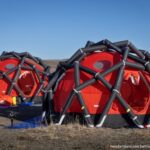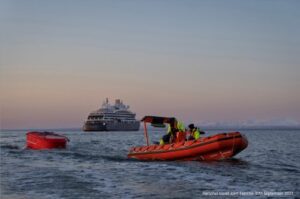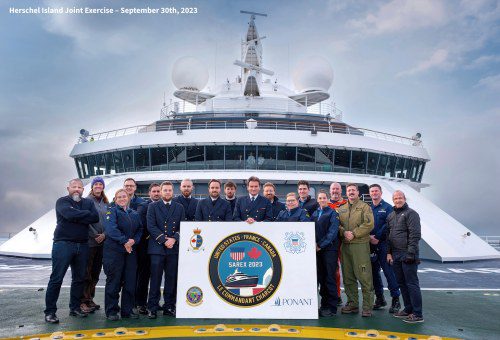 As the experts in polar zone navigation for more than 20 years, PONANT continues to innovate and advance maritime safety standards. Le Commandant Charcot was at the centre of a second safety exercise in the polar region on 30 September 2023 at Herschel Island in the Northwest Passage. The PONANT teams aboard and ashore were fully mobilised in this exercise carried out on an unprecedented scale.
As the experts in polar zone navigation for more than 20 years, PONANT continues to innovate and advance maritime safety standards. Le Commandant Charcot was at the centre of a second safety exercise in the polar region on 30 September 2023 at Herschel Island in the Northwest Passage. The PONANT teams aboard and ashore were fully mobilised in this exercise carried out on an unprecedented scale.
The operation was also supported by the Joint Rescue Coordination Centre based at 8 Wing Trenton (Ontario, Canada), run jointly by the Royal Canadian Air force (RCAF) and Canadian Coast Guard (CCG). It involved the U.S. Coast Guard District Seventeen and Air Station Kodiak (Alaska) and a command unit at the PONANT head office in Marseille (France). This exercise spanned 10 time zones and more than a hundred people were mobilised over a 12-hour period.
“We carried out a first rescue exercise on the ice in September 2021 during the ship’s trial voyage. This time, the operation took place in ice-free water. It’s a world first that allowed us to test our procedures and equipment, as well as the coordination with the Canadian and American services” explained the Captain, Patrick Marchesseau, on Le Commandant Charcot. “This joint exercise and sharing of our expertise is contributing to advances in safety for the entire polar maritime and tourism industry”.
“This incredible endeavour demonstrates PONANT’s commitment to safety and excellence in all our operations” says Chris Hall, PONANT CEO Asia Pacific, “Safety is one of the key pillars in our Explore to Inspire ambitions and we hope marine exercises such as this inspire guests, new and existing, to travel with PONANT now and in the future”.

Onboard, 65 participants (including 24 passengers) were evacuated to an island in a heated lifeboat and then equipped with suits specially designed by PONANT. The Ice Cube, an innovative piece of equipment that was also developed by PONANT to transport survival kits, was towed by the lifeboat and hoisted ashore and polar shelters were set up, some of which have been tested with a heating mode. The lifeboat was used as a hospital during the 1st part of the LIVEX. For this joint exercise, the Royal Canadian Air Force deployed a CC-130H Hercules, a CH-149 Cormorant helicopter and a CC-138 Twin Otter and the United States Coast Guard deployed a C-130J Super Hercules and an MH-60T Jayhawk. The aircraft were used to drop survival equipment, parachuting in rescue teams and evacuating participants.
This joint exercise showcases extensive international collaboration aimed at strengthening maritime safety standards. This experience will benefit the entire industry.



















